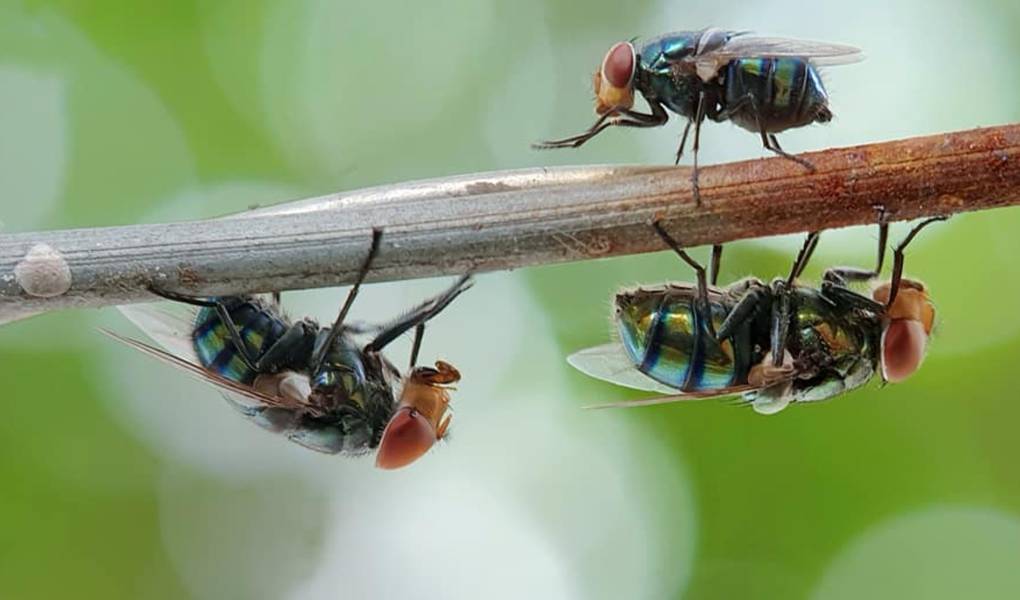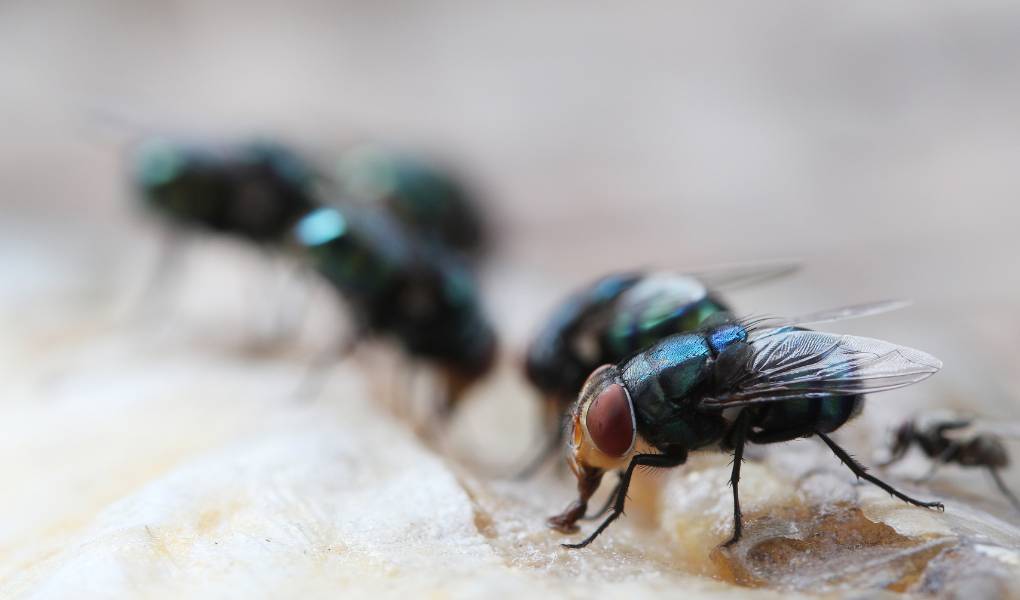Explanation of the sudden influx of flies in the house
The sudden influx of flies in the house can be attributed to potential breeding grounds within the household. Common areas where flies may breed include garbage bins, uncleaned cupboards, and damp basements. These areas provide suitable conditions for flies to lay eggs and for larvae to pupate into adults.
Larvae pupating into adult flies may have led to the sudden increase in flies, as the warm and moist environments in these breeding grounds are ideal for the development of fly larvae.
Potential areas where eggs and larvae may have been left undisturbed to provide sufficient food for development include rotting organic matter in garbage bins, spilled food in uncleaned cupboards, and stagnant water in basements. Flies lay their eggs in these areas, and the undisturbed environment allows for the eggs to hatch and the larvae to feed and develop undisturbed.
To tackle the sudden influx of flies, it is important to identify and clean these potential breeding grounds to disrupt the life cycle of the flies. Proper sanitation and regular cleaning of these areas can help prevent future infestations of flies in the household.
Understanding Cluster Flies
Cluster flies are a common nuisance in many households, especially during the cooler months. These flies often seek shelter in homes and other buildings to escape the cold, clustering in large numbers and causing frustration for homeowners. Understanding the behavior, lifecycle, and habits of cluster flies can help in finding effective ways to control and prevent infestations. By learning more about these pests, homeowners can better equip themselves to deal with cluster fly problems and keep their homes insect-free.
Definition and characteristics of cluster flies
Cluster flies, also known as attic flies or “winter flies”, are overwintering pests that are native to Europe. They are similar in appearance to common household flies, with a dull gray color and golden hairs on their thorax. However, they are slightly larger and slower in their movements. Adult flies are known for their habit of clustering in large numbers inside attics, especially during the fall and winter months. This behavior is a result of their overwintering habits, as they seek shelter in warm, protected areas to survive the cold season.
Unlike common household flies, cluster flies do not breed indoors or infest food sources. Instead, they lay their eggs in the soil, where the larvae parasitize earthworms. They are often introduced to North America through imported soil and plants, and their populations are influenced by rainfall patterns.
Overall, cluster flies are a nuisance due to their large numbers and tendency to congregate indoors, particularly in attics. Their distinct behavior and overwintering habits set them apart from common household flies, making them a unique pest species in the home.
Differences between cluster flies and house flies
Cluster flies and house flies have several physical differences. Cluster flies are larger, measuring about 8-10 millimeters in length, compared to house flies which are generally smaller, at around 6-7 millimeters. Cluster flies have a dark grayish-brown thorax with golden-yellow hairs on the body, while house flies have a gray thorax with black longitudinal stripes. When at rest, cluster flies overlap their wings over their back, while house flies keep their wings separated. Cluster flies are also known for their sluggish behavior and tend to gather in large numbers in attics and wall voids during the winter, while house flies are more active and prefer to lay their eggs in decaying organic material.
Cluster flies do not carry disease and have a longer lifespan compared to house flies. While house flies can transmit diseases such as dysentery and typhoid fever, cluster flies are not known to carry any harmful pathogens. Additionally, cluster flies can live for several months, whereas house flies only have a lifespan of about 15-25 days.
The damage caused by cluster flies differs from that caused by house flies. Cluster flies do not feed or reproduce indoors but may leave behind fecal spots and a musty odor. In contrast, house flies feed on human food, animal feed, and organic waste, and can contaminate it with their feces and regurgitated gut contents, potentially spreading diseases.
In summary, the physical differences, behaviors, habitat preferences, disease-carrying capabilities, lifespan, and types of damage caused differentiate cluster flies from house flies.

Identifying Cluster Fly Infestation
If you are noticing an abundance of sluggish, dark-colored flies in your home during the fall and winter months, you may be dealing with a cluster fly infestation. Identifying a cluster fly infestation can be essential in taking the necessary steps to eliminate and prevent their presence in your home. From recognizing their appearance and behavior to understanding the areas they are commonly found, being able to identify a cluster fly infestation is the first step in effectively addressing this pest problem. Keep reading to learn how to identify a cluster fly infestation and what steps you can take to manage it.
Signs of a cluster fly infestation in the house
Signs of a cluster fly infestation in the house include a sickly rich smell, swarming flies when disturbed, a large number of flies in windows, and fly feces around windows. These flies typically appear in the spring and fall, seeking shelter in homes to hibernate during the winter. While they do not cause any damage to the home, they can be a significant nuisance, especially when they emerge in large numbers. Cluster flies are attracted to the warm and sunny sides of homes and often gather in secluded areas such as attics, wall voids, and unused rooms.
To prevent and manage a cluster fly infestation, sealing cracks and gaps in the home’s exterior, using window screens, and keeping the home clean and free of food sources can be helpful. Additionally, using fly traps and insecticides can help control the population. It is important to address the infestation promptly to prevent the flies from multiplying and becoming a larger problem. Consulting with a pest control professional may also be necessary in severe infestation cases.
Differentiating between cluster flies and other fly species
Cluster flies are larger and slower-moving compared to other common household fly species such as house flies and fruit flies. They have a distinct grayish-black colored thorax with golden hairs and their wings overlap when at rest.
Unlike other fly species, cluster flies tend to gather in large numbers and are commonly found in attics, wall voids, and other secluded areas during the winter months. They are known for their habit of clustering together in groups, hence the name “cluster flies.” When disturbed, they tend to fly in a sluggish and erratic manner.
One way to distinguish cluster flies from other fly species is by their behavior during the winter months. They seek shelter indoors to hibernate, often entering homes through small cracks and gaps. This behavior separates them from house flies and fruit flies, which are more active and less likely to seek shelter indoors.
In comparison to other fly species, cluster flies are less of a nuisance indoors as they do not lay eggs or feed on food sources. However, their large numbers and slow movement can be a cause of concern for homeowners.

Understanding Cluster Fly Behavior
Cluster flies, also known as attic flies, are a common nuisance in many households. These flies are often found in large numbers during the fall and winter months, seeking shelter in warm, protected areas like attics and wall voids. Understanding their behavior is crucial for effective control and prevention. By learning about their habits, lifecycle, and preferred environments, homeowners and pest control professionals can develop strategies to eliminate and prevent cluster fly infestations. Additionally, understanding cluster fly behavior can also help in identifying potential entry points and implementing exclusion measures to keep them out of the home. With the right knowledge, it is possible to minimize the impact of cluster flies on living spaces and ensure a more comfortable and pest-free environment for occupants.
Reasons why cluster flies enter houses during winter months
Cluster flies enter houses during the winter months for several reasons. Firstly, they are attracted to warm and dry environments for overwintering. As the temperature drops, they seek shelter in homes to escape the cold. Secondly, they are also seeking a food source to lay their eggs. Cluster flies are attracted to decaying organic matter, which can often be found in and around homes.
Potential entry points for cluster flies include gaps around windows and doors, cracks in walls, and openings in the roof or attic. By sealing any of these entry points, homeowners can prevent cluster flies from entering the house. This can be done using caulk, weather-stripping, and mesh screens to cover vents and openings. Regular maintenance of the exterior of the house, such as trimming vegetation and sealing gaps, can also help to deter cluster flies from entering.
In conclusion, cluster flies enter houses during the winter months due to their attraction to warm and dry environments for overwintering and their search for a food source to lay their eggs. By identifying and sealing potential entry points, homeowners can effectively prevent cluster flies from invading their homes.
Attraction to warm wall voids and window frames
Warm wall voids and window frames offer a conducive environment for insects and pests due to their warmth and protection from the elements. Insects are drawn to these areas because they provide a suitable temperature for nesting and breeding. Additionally, these spaces often provide access to food sources such as crumbs, spills, and other organic materials that accumulate in these areas.
To address the attraction of insects and pests to warm wall voids and window frames, it is essential to seal off entry points to prevent their access to these areas. This can be done by repairing any cracks or gaps in walls and window frames. Regular cleaning and maintenance can also help eliminate food sources. Additionally, utilizing pest control measures such as insect repellents or traps can help in managing the insect population in these areas.
By addressing these key factors, the attraction of insects and pests to warm wall voids and window frames can be effectively minimized, creating a less hospitable environment for these unwanted guests.
Sources of Food for Cluster Flies
Cluster flies are a common nuisance in many homes and businesses, especially during the fall and winter months. To effectively manage these pests, it’s essential to understand their sources of food. From overripe fruits and vegetables to decaying organic matter and animal waste, cluster flies are attracted to a variety of food sources. By identifying and addressing these sources, you can help prevent and control cluster fly infestations in your property.
Organic matter as a food source for adult cluster flies
Organic matter plays a crucial role as a food source for adult cluster flies. These flies are known to prefer feeding on plant sap, flower nectar, and ripe fruits. Their ground-based lifestyle allows them easy access to these food sources, as they are commonly found in fields, gardens, and orchards. They are also attracted to warmth from sunlight, making them often seen sunning themselves on walls and windows of buildings.
The presence of organic matter is one of the key contributors to the presence of cluster flies in homes. As they search for food sources, they may find their way into homes through small openings or cracks. Once inside, they may be attracted to organic matter such as fruits or flowers, as well as the warmth and shelter that homes provide. This can lead to cluster flies becoming a common nuisance in homes, particularly during the fall when they seek shelter to overwinter.
In summary, organic matter serves as a vital food source for adult cluster flies, supporting their ground-based lifestyle and attracting them to warmth from sunlight. This, in turn, can contribute to their presence in homes as they seek food and shelter.

Role of garbage cans and pet food in attracting cluster flies
Garbage cans and pet food can attract cluster flies in several ways. Garbage cans can attract cluster flies when they are not tightly sealed, allowing the flies to access organic waste and decaying matter. Similarly, pet food can also attract cluster flies if it is left uncovered or if it is spilled and not promptly cleaned up. The strong odor of pet food can lure cluster flies to the area, leading to an infestation.
It is important to keep garbage cans tightly sealed and ensure pet food is stored in airtight containers to prevent cluster fly infestations. By doing so, the attractive odors and access to organic matter are minimized, decreasing the likelihood of cluster flies being drawn to these areas.
Regular cleaning of garbage cans and pet feeding areas is crucial in preventing cluster fly infestations. This includes promptly removing spilled pet food, cleaning pet feeding areas, and regularly emptying and cleaning garbage cans to eliminate any potential attractants for cluster flies. By maintaining cleanliness and proper storage, the likelihood of cluster fly infestations can be significantly reduced.
Prevention Measures to Reduce Cluster Fly Infestation
Cluster flies are a common nuisance in homes and buildings, especially during the fall and winter months. To prevent the infestation of these annoying pests, it is essential to implement several preventive measures. By taking proactive steps and making a few changes to your property, you can significantly reduce the chances of cluster flies invading your space. Here are some effective prevention measures to keep your home or building free from cluster fly infestations.
Sealing potential entry points, such as electrical outlets and window frames
When inspecting your shed for potential entry points for cluster flies, be sure to thoroughly examine all electrical outlets and window frames for any cracks, gaps, or openings. Use caulk or sealant to fill in any broken seals or cracks around these areas to prevent cluster flies from entering your shed. It is important to ensure that all potential entry points are properly sealed to keep cluster flies out and maintain a pest-free environment.
Start by carefully examining each electrical outlet and window frame, paying close attention to any areas where there may be gaps or openings. Use a caulk or sealant specifically designed for outdoor use to fill in any cracks or gaps, creating a secure seal that prevents cluster flies from finding their way inside. Pay special attention to the areas around the electrical outlets and window frames, as these are common entry points for pests.
By following these steps and sealing any potential entry points with caulk or sealant, you can effectively prevent cluster flies from entering your shed and protect your space from unwanted pests.
FAQ’S:
Why are there suddenly a lot of flies in my house?
Cluster flies typically enter homes in search of warmth and shelter during the colder months.
How do I identify cluster flies?
Cluster flies are slightly larger than house flies and have a distinctive dark gray or blackish coloring with golden hairs on their thorax.
What attracts cluster flies to my house?
Cluster flies are attracted to sunny and warm areas, so they may be drawn to your home if it has exposedsouth-facing walls, attics, or sunny spots on the roof.
How can I prevent cluster flies from entering my house?
- Seal any cracks or gaps in windows, doors, and other potential entry points.
- Ensure proper ventilation and insulation in attics and crawl spaces.
- Use screens on windows and vents to prevent fly entry.
- Keep your house clean and free from food debris.
How can I get rid of cluster flies already inside my house?
- Use a vacuum cleaner to suck up the flies.
- Use an aerosol insecticide approved for indoor use to kill existing flies.
- Light traps or flypapers can help in capturing and eliminating cluster flies.
Are there any natural remedies to repel or eliminate cluster flies?
- Essential oil sprays, such as lavender or citronella, may repel cluster flies.
- Fly swatters or electric fly zappers are environmentally friendly options.
Can professional pest control services help with cluster fly infestations?
Yes, professional pest control services have effective methods to exterminate cluster flies and prevent future infestations.
How often should I clean my house to prevent cluster flies?
Regular cleaning and thorough sanitation routines are essential to keep flies from being attracted to your home.
Need to get rid of cluster flies? call Attic Crew today for the best rodent proofing and pest control solutions.



